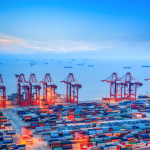Yes, Port Congestion Is Still Bad & Not Going Away Soon
We’re not completely bereft of signs that port congestion, which is so costly to shippers, could start easing soon; however, congestion is at record-setting levels and what’s probably the biggest cause of that congestion at U.S. ports persists: high cargo volume.

A couple months of high cargo isn’t really a problem. The international shipping industry has its peak season every year when more cargo than normal comes through the ports for a few months. Then the cargo traffic reduces, and if a little congestion was happening, it clears up. However, what happens if that cargo traffic doesn’t reduce? That’s basically what we’re seeing right now.
Greg Miller reports in American Shipper that the congestion happening right now at the Ports of Los Angeles and Long Beach makes the horrific congestion we saw there in 2015 because of the labor strife during long, contentious contract negotiations pale in comparison. That’s saying something as I wrote many blogs about the agricultural exports rotting on the docks, goods failing to get to store shelves, and billions of dollars in damage done to the U.S. economy during the 2014-15 congestion.
Cause of Congestion
For more than half a year, cargo volumes have been at near-record and record highs. That’s a long time to handle the kind of volume we’re seeing at places like the Ports of Los Angeles and Long Beach. That could have been enough on its own to create severe congestion. However, from the start of these high volumes, there have been other issues plaguing the movement of goods. At the top of these other factors is equipment shortages.
Carriers blanked (cancelled) hundreds of sailings in the lead up to this high volume in order to lower capacity and raise freight rates. Early in 2020 with the onset of COVID-19, it was expected ocean freight carriers would lose billions. Instead, carriers used extreme amounts of blanked sailings to control capacity, shrinking it well below market demand, and push freight rates way up. One of the problems this created was failure to reallocate needed shipping containers. All this while demand was higher than expected because lockdowns and government stimulus had Americans buying goods at high rates when money couldn’t be spent on services, entertainment, and travel, which usually get more market share of spending.
Shortages of containers and other equipment, along with pandemic-related protocols that reduce productivity, contributed to congestion right from the start of this period of high cargo volume being shipped.
Is Cargo Volume Reducing?
Usually, the Chinese New Year brings much reduced volume of imported cargo as factories in China close for a couple weeks. If there was some leftover congestion from particularly strong peak and holiday seasons, this is a good time to catch up.
However, China kept factories open through its Spring Festival holiday this year, as we blogged about last month when the Lunar New Year arrived, to keep up with increased demand for goods and discourage travel over concerns that it would spike coronavirus transmission.
There did, however, still seem to be cargo volume reduction during the Chinese New Year time. Looking at Universal Cargo’s shipment counts, which I often use as a barometer for the international shipping industry, February’s cargo volume came down some from the high cargo volume we’d been seeing moved through the ports for months. Universal Cargo actually saw about a 20% reduction in shipments in February as compared to January. That’s a very significant drop. However, February’s volume would still be considered strong and March’s volume shot back up. March’s shipment count is currently about 4% higher than January’s total was (of course, some of the cargo estimated for the end of March could push back into early April).
As it looks likely a third stimulus check for Americans, this time of $1,400, is getting geared up to be voted on in another COVID-19 relief bill (though there’s plenty in the bill that has nothing to do with the pandemic), that could very well keep the heavy spending on goods continuing a little longer. On the other hand, lockdowns should be easing more and more, allowing spending on going out, entertainment, and travel to increase at the cost of spending on goods. Eventually, the loss of jobs and permanent closing of businesses caused by the lockdowns will catch up to the economy, slowing spending on goods as well. In fact, the risk of a crash from the spending that comes out of trillions of dollars in stimulus that the government doesn’t actually have while so many businesses have been destroyed by too often draconian rules is extremely high.
Conclusion
While an end to the high, high cargo movement we’ve been seeing does appear to be on it’s way, it seems like it will be delayed a little longer. Thus, delays will continue at the ports. Even when cargo volume does reduce, it will take some time to clear up the congestion we’re seeing.
The extremely high freight rates we continue to see (though a slight easing up is starting to be seen), has some shippers moving away from importing from China. We’ll look at that in the next post…




